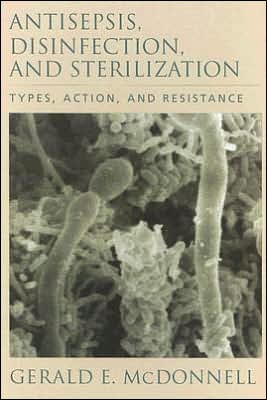Antisepsis, Disinfection, and Sterilization: Types, Action, and Resistance
Antisepsis, Disinfection, and Sterilization examines the various chemical and physical antisepsis, disinfection, and sterilization methods used for infection prevention and contamination control. Targeting microbiologists, chemists, facilities managers, health care professionals, infection and contamination control practitioners, application engineers, and students, and is a valuable reference written by an acknowledged expert working in the field.
Search in google:
Antisepsis, Disinfection, and Sterilization examines the various chemical and physical antisepsis, disinfection, and sterilization methods used for infection prevention and contamination control. Targeting microbiologists, chemists, facilities managers, health care professionals, infection and contamination control practitioners, application engineers, and students, and is a valuable reference written by an acknowledged expert working in the field. Doody Review Services Reviewer:Robert Gene Penn, MD(Nebraska Methodist Hospital)Description:This comprehensive review of the various chemical and physical antisepsis, disinfection, and sterilization methods discusses the current understanding of mechanisms of biocidal action on microorganisms. The last and most lengthy chapter describes the current knowledge of biocide resistance in bacteria, and the less studied mechanisms of resistance in viruses, prions, fungi, and eukaryotes. Purpose:The book is intended to provide a basic understanding of the various chemical and physical antisepsis, disinfection, and sterilization methods used for infection prevention and contamination control. The author succeeds in providing a comprehensive review of the types, actions, and practical uses of the available biocidal methods.Audience:It is targeted at healthcare professionals involved in infection control and prevention, application engineers, facilities managers, microbiologists, chemists, and students. The author is an acknowledged expert working in the field.Features:A general introduction provides a review of terminology, definitions, and a background of pertinent microbiology. An array of physical and chemical agents are described, including specific types, practical uses, spectrum of activity, and variables affecting their safe and effective use. The mechanisms of action of biocides are covered in four general groups: oxidizing agents, cross-linking agents, action by transfer of energy, and other structure-disrupting agents. Current knowledge of the natural and acquired mechanisms that microorganisms employ to resist the biocidal effects of chemical and physical processes is explored.Assessment:Students and healthcare professionals of infection control, microbiology, and public health will be able to use this as a reliable reference for the various chemical and physical antisepsis, disinfection, and sterilization methods. The book will provide a greater understanding and appreciation of these technologies used in contamination and infection prevention. In return, this will help ensure their long-term safe and effective use.
\ From The CriticsReviewer: Robert G. Penn, MD(Nebraska Methodist Hospital)\ Description: This comprehensive review of the various chemical and physical antisepsis, disinfection, and sterilization methods discusses the current understanding of mechanisms of biocidal action on microorganisms. The last and most lengthy chapter describes the current knowledge of biocide resistance in bacteria, and the less studied mechanisms of resistance in viruses, prions, fungi, and eukaryotes. \ Purpose: The book is intended to provide a basic understanding of the various chemical and physical antisepsis, disinfection, and sterilization methods used for infection prevention and contamination control. The author succeeds in providing a comprehensive review of the types, actions, and practical uses of the available biocidal methods.\ Audience: It is targeted at healthcare professionals involved in infection control and prevention, application engineers, facilities managers, microbiologists, chemists, and students. The author is an acknowledged expert working in the field.\ Features: A general introduction provides a review of terminology, definitions, and a background of pertinent microbiology. An array of physical and chemical agents are described, including specific types, practical uses, spectrum of activity, and variables affecting their safe and effective use. The mechanisms of action of biocides are covered in four general groups: oxidizing agents, cross-linking agents, action by transfer of energy, and other structure-disrupting agents. Current knowledge of the natural and acquired mechanisms that microorganisms employ to resist the biocidal effects of chemical and physical processes is explored.\ Assessment: Students and healthcare professionals of infection control, microbiology, and public health will be able to use this as a reliable reference for the various chemical and physical antisepsis, disinfection, and sterilization methods. The book will provide a greater understanding and appreciation of these technologies used in contamination and infection prevention. In return, this will help ensure their long-term safe and effective use.\ \








